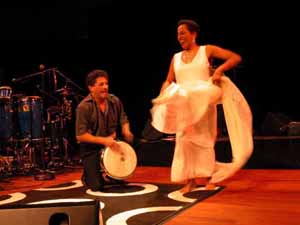MARTA GÓMEZ / “La Ronda”
I recently heard a song that reminds me of one of my favorite singers, Susana Baca. The song is “La Ronda” by a young Colombian singer-songwriter, Marta Gómez. "La Ronda" is from Marta’s album Solo Es Vivir.
 I like the way the vocals sound soft and tough at the same time and I really like the rhythms (especially the drum break that comes right in the middle of the song). The lyrics are nice, too. Marta’s singing in Spanish, but she has English language translations of all her lyrics on her website. Verse two of “La Ronda” goes like this:
I like the way the vocals sound soft and tough at the same time and I really like the rhythms (especially the drum break that comes right in the middle of the song). The lyrics are nice, too. Marta’s singing in Spanish, but she has English language translations of all her lyrics on her website. Verse two of “La Ronda” goes like this:
Let's pretend we're riding horsies Mine will be the sea and yours will be the sand Let's just go faster and faster as fast as they can Let's also invite the moon and the sun The peace and the war And we will see then that all the problems will endThat’s hip: a love song, a children’s song and a wish for peace, all in one. When I did a little research, I discovered there was a good reason I was hearing a little Susana Baca in Marta’s song. Marta is from Colombia, but her song “La Ronda” is based on rhythms that come from Colombia’s neighbor to the south, Peru. The rhythm in question is landó, a word, a dance and a musical style that all can be traced back to the slaves who were brought to Peru from Africa. In an online article entitled “From Chains To Celebration,” one writer describes how the African slaves of Peru maintained their rhythms even though the slave masters outlawed musical instruments, including of course, drums:
Wooden fruit crates evolved into the cajon, which people straddled and beat with their hands. Church collection boxes gave rise to the cajita, which they clapped open and shut, and beat with a stick. Donkey jawbones developed into the quijada de burro, which they beat with the palm of the hand, causing the bone to resonate like a tuning fork and the teeth to rattle.The descendants of the Peruvian slaves used these ‘found’ instruments, along with the half-remembered rhythms of their African homeland, to create a new musical style that persists, and persists beautifully, to this day. From blues musicians playing guitars with soft drink bottles to Jamaican kids ‘talking over’ instrumentals of other people’s records to jazz musicians using Tin Pan Alley ditties as fodder for improvisation, this creative resourcefulness is one of the most persistent themes in the history of black music. Over and over we find that the music defeats any obstacles it must to keep on keeping on. And oftentimes, we find that the bitterness the musicians must endure only succeeds in making the music that much sweeter.
 The first is "Zamba Malató" from Susana Baca’s self-titled 1997 CD. Baca says abut this tune:
The first is "Zamba Malató" from Susana Baca’s self-titled 1997 CD. Baca says abut this tune:
The zamba malató is a style believed to be derived from traditional landó. Recovered by Nicómedes Santa Cruz, the music has African words that, like everything in the oral tradition, have lost significance or have been distorted in their pronunciation, leaving them now as rhythmic elements.And here’s a collective named Perú Negro, ‘the cultural ambassadors of Black Peru,’ doing their version of the same tune although they call it “Samba Malató.” To my ears, Perú Negro's version, which is taken from their 2001 release Sangre De Un Don, is less sophisticated and less ‘musical’ than Baca’s. Also, the lead singer’s vocals have a shrill edge that we in America would call ‘country,’ while Susana’s vocals (like those of Marta Gómez) are as smooth and tuneful as any you’ll hear anywhere. I’m also not convinced that the verses are the same. In any event, whichever of these versions you prefer—the smooth city vibe, the raw country sound, or the Colombian interpretation—I hope you dig the landó. —Mtume ya Salaam Believe it or not Mtume and I don’t do much plotting and planning. Usually we just divide up the lead role and see where it goes from there. Occasionally we will decide to devote the whole week to one artist or one theme, but even then we don’t pick all the music in advance. I think it’s good that BoL is not pre-planned, all of the songs picked out and agreed on in advance. Why? I like writing in the moment. We’re not second-guessing ourselves or each other. Most of the time, we have (far) less than 24 hours to write our response to the other person’s selections. Although there is a lot more to write and more time would allow for research, fact-checking, etc. etc. After a while editing and re-writing kills the fun of writing about music we love (or, in a few cases, can’t stand). All of which is to say when I opened our shared folder and saw that Marta Gómez was Mtume’s contemporary pick, I smiled. First of all because I’ve been into Marta’s music for years. I have three of her four albums on my hard drive and the fourth is in my CD collection. (Apropos of digital technology, even though I have a collection of well over 4,000 CDs, I’m approaching, if I have not already caught up to the CDs in terms of digital music on a hard drive. And yes, I have a backup of all the digital music.) Trivia: Mtume’s ex-wife spent most of her childhood in Columbia. I don’t remember either of us ever discussing Marta Gómez; we each got to her music on our own paths. I’m pretty sure, however, our positive responses are informed, if not inspired, by our mutual love for Susana Baca. It only takes a minute of listening to Marta to make it clear that if one loves Susana Baca, you’ve got to like Marta Gómez. I've added "Maria Mulata" (from Ms. Gómez’s album Cantos De Agua Dulce) in the jukebox. It’s in a similar vein. Indeed, I selected six cuts and did a feature length write-up but it just got to be a (good) bit much, so we'll feature Marta Gómez next week. Meanwhile enjoy this foray into contemporary Latin folk music with an Afro-rhythmic twist. And what an elegant twist it is. —Kalamu ya Salaam
This entry was posted on Monday, February 25th, 2008 at 1:40 am and is filed under Contemporary. You can follow any responses to this entry through the RSS 2.0 feed. You can leave a response, or trackback from your own site.
Leave a Reply
| top |